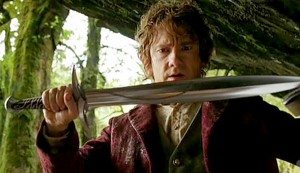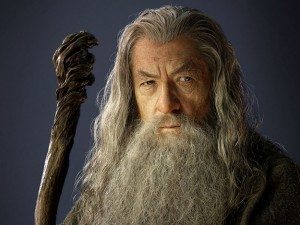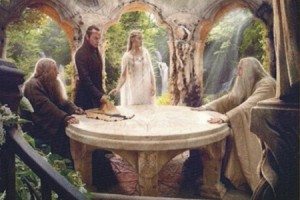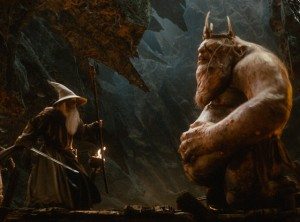The Hobbit, as presented at 48fps* (i.e. high frame rate, HFR), marks the death of cinema. At least digital projection, depressing as it is, is being improved to the point where it’s starting to resemble film. Which is the point—to resemble film. To be a movie. What The Hobbit shows us is something completely different, something divorced entirely from what is thought of as a “movie.” It looks, at various times during its three unbelievably long and bloated hours, like: a video game, a cable TV historical re-enactment, an especially crisp videotape your friend’s creepy older brother shot at a Fresno renn faire, a BBC documentary, an even worse video game, and a workplace instructional video for new fry cooks.
It was this morning when the worst realization hit me: despite the hugeness of it, despite the action sequences, the spectacle, the money spent, The Hobbit in HFR would look best watched on an iPad.
It’s so bad I’m not even sure how to talk about the movie itself. It’s so distracting to look at that nothing else matters. If you want a reasoned discussion, check out The Evil Genius’s take. I can do nothing but sputter and rant.
What was Peter Jackson thinking? Get this:
When you see 48 frames and you see the realism and…the smoothness of the motion, it’s not what you associate with going and seeing a film…A high frame rate is fantastic. It really makes you feel like you’re there.
If by “there” he means “on the toilet watching a movie on your phone,” then yes, that’s exactly right. Also correct: it is indeed not at all what you associate with going to see a film. This is a technology for people who hate movies. Do you love the way video games look and feel? Perfect. This is the movie for you. The smoothness of the motion? Try this: wave your hand in front of you face. See how it blurs? The HFR eliminates this, just like in videogames. The lack of blur makes motion in the movie appear freakishly sped up. It doesn’t look real at all. It couldn’t look more fake.
Oh, there’s more:
As a filmmake it’s a joy because it gives a more immersive, realistic feel. It’s much more gentle on the eyes. You don’t get the eye strain and headaches.
Did this interview take place on Earth 2? What the fuck is he talking about? A three hour CGI movie in 3D at 48fps isn’t going to give you eye strain and headaches? But a 90 minute movie shot on film projected the way every living person has ever watched a movie is hard on the eyes?
So we begin to see what’s going on here. Peter Jackson is insane. To wit: “24 frames is jarring to me now.”
Watched The Lord of The Rings lately? Remember thinking how jarring it looked? Right. Neither did any of the other human beings who live on Earth.
If I’ve been vague, let me just say it outright: if you must see The Hobbit, see it projected at a normal frame rate.
Must you see The Hobbit? I’d advise against it. As a story, it’s a mess. How does a movie that lasts almost three hours manage to tell you nothing about the characters? Aside from the king of the dwarves, distinguishable because he has all the lines, I couldn’t tell you a single thing about the other ten or eleven or thirteen of them. That’s not true. There’s a fat one. A stupid looking one. One with a moustache. Also, there’s a hobbit. Martin Freeman is fine as Bilbo. Unfortunately, he has about ten minutes of things to do in this movie. He spends most of his time running or gaping silently while Gandalf explains things.
For the action sequences, Jackson uses the same logic he used for his appalling King Kong (’05) remake: more is better. More orcs, more goblins, more running and stabbing and falling. I’ve never seen so many characters plummet down thousand foot crevasses and live. All of the action sequences look like those videogame interludes that play out between levels.
There’s simply no one to care about in The Hobbit. The only scenes with any weight at all are those that relate to The Lord of The Rings, one of which, the conversation between Gandalf, Saruman, Elrond and Galadriel, having been invented for the movie, feels odd and out of place. The other scene with weight is when Biblo finds the ring.
The scene with Gollum (the always entertaining Andy Serkis) isn’t bad. Although even Gollum feels less compelling than he did in The Lord of The Rings. Bilbo sort of outwits him, and as Gollum rants and raves, Bilbo puts on the ring and turns invisible. It takes him a while to realize he can’t be seen, yet there seems to be a moment missing, one where we see him react with wonder to what must be a rather odd property for a ring to possess. He seems to take it as a matter of course. Which is what we the audience are doing. We know all about the ring. But how does Bilbo?
The Hobbit is meant to be a children’s book, unike the more adult The Lord of The Rings. It was never going to be as dark and foreboding and evil as those former movies. But shouldn’t a children’s story be character-based? Why the need for epic CGI battles that never stop? No sooner does one breathless chase sequence end than another one begins. Rock monsters rain granite on our heroes, they survive. Thousands of swarming goblins attack, they survive. Orcs by the orcload swarm, and everyone’s fine. There’s no sense of danger in the movie whatsoever. Without that, there’s no drama.
Put it this way: every scene in The Lord of The Rings involving only Sam and Frodo is better than every scene in The Hobbit. Those two hobbits you care about. Peter Jackson cared about them too. In this one, all he seems to care about is the look. And the look is the worst part.
* Frame rates varied at the beginning of the film era. Old silent films used as few as 14 frames per second, which is why old movies, when their speed is uncorrected, will appear extra speedy, with their 14fps footage shown at 24fps. By 1930, 24fps had become the standard for film, which to this day it remains.







as with practically all marketing, make up a problem that doesn’t really exist and then gift us with the solution to it.
Innovation is often met with incredulity.
“They all laughed at Christopher Columbus
When he said the world was round
They all laughed when Edison recorded sound
They all laughed at Wilbur and his brother
When they said that man could fly
They told Marconi
Wireless was a phony
It’s the same old cry.
They all laughed at them and how
But Ha Ha Ha
Who’s got the last laugh now?”
And they told Hans Laube Smellovision stunk. And they were right.
SB isn’t hating 48fps because its new and he’s closed-minded. He hated it, as did I, because it looked terrible. Whether or not it will ever look good; can’t say. In The Hobbit it was just plain bad.
Yes, I’m afraid that quoting Ira Gershwin lyrics isn’t going to cut it here. And I’m a little dubious in general that projecting at 48fps is the equivalent of sound recording, flight, and the rotundity of the earth.
HFR looks like crap. Its only conceivable purpose is to solve the ‘problem’ of what movies currently look like. That there is such a problem is an extremely dodgy proposition. I think film looks fantastic. Even if we allow that it doesn’t look fantastic, what is HFR offering us?
I guess the issue here is that only if you have a problem with 24fps projection will HFR appear as a solution. And who has a problem with 24fps? So far, Peter Jackson and James Cameron, who’s going to do his Avatar sequels with HFR. For the rest of humanity, HFR looks like ass.
But if I’m loving HFR ten years from now, if it instantly sweeps all of filmdom as did the advent of sound and color, I’ll gladly print out and eat these words. But I’m guessing it’s going to be like 3D, a gimmick.
Love your post. You are spot on about so much. The Hobbit at 48 fps looked like the most extravagant episode of Fraggle Rock ever. I’m not surprised teenage fan-boys love the HFR look, but if I had to watch a Woody Allen film at 48 fps, I’d throw something at the screen. In fairness, I think whether one accepts this new aesthetic is somewhat of a generational thing. You know, I remember when I first played a video game that looked like a 35mm Hollywood film. I was confused — wait, am *I* controlling this? All the visual cues were telling me to sit back and watch. Here it was the opposite — when the orcs and dwarves (and camera) started flying across those catwalks in the mine sequence, I wanted to grab a joystick. So maybe it is learned. But still, I had to take a triptan when I got home. One interesting note — Edison’s first camera, the Kinetograph, used 48 frames per second. I guess we’ve come full circle.
I suppose it’s true that the young’uns, who have no history of watching film, could very well end up liking 48fps better. If it’s what they grow up with it, that’s what’s going to happen. Too bad for them.
Maybe it comes down to the same problem I so often have with CGI: that it tries above all to mimic reality. I don’t see the benefit in this. Movies, ideally, are art, and there’s no point in art trying to mimic the actual world. Art is an interpretation of the world, a way of looking at the world. Through art, you see the world through someone else’s eyes, giving you new insights into it–a new way of looking at it–and insight into the artist who sees it that way.
The best filmmakers aren’t trying to mimic reality, they’re trying to create a world in a movie that is consistent with itself, and through its stylization, however subtle or extravagant, to suggest something, anything, about life out here in the real world.
If the goal is just to make things seem more ‘real,’ what have you got? Unless you succeed perfectly–which you won’t, ever–you necessarily fail. Inevitably, you’re always creating artifice. That’s what a movie is. Good filmmakers embrace stylization, because it’s something they can control, it’s something they can succeed in. It’s what movies are.
The look of film, at 24fps, is itself a kind of stylization. It’s beautiful and versatile. Digital projection has already lessened the impact of movies. HFR, at least with the one example we have so far, has lessened it even more. Maybe it’ll just be a different thing and people will find powerful ways to use it. I hope so. We shall see…
The Hobbit Movie: A long awaited disaster…….
.maybe now, they will just leave Tolkiens Middle Earth books alone, and those that hate them can move on to something else, and those that love them can have them back.